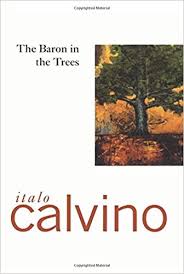The Baron in the Trees by Italo Calvino, Italy, 1957

I launched into this book by Calvino with much enthusiasm, having read and enjoyed If on a winter’s night a traveller. Unfortunately the first pages are filled with reference to a creature to which I have a very real and paralysing phobia. I skimmed those pages, but the word, popping up as it does every couple of paragraphs, placed the creature front and centre in my mind, and nothing I did was able to erase it. Had I not enjoyed If on a winter’s night, a traveller I probably would have put the book to one side (or handed it in to second-hand bookshop), but my recognition of Calvino as an author worth reading forced me to continue reading.
These opening pages definitely impacted on my enjoyment of the book; it also made me realize that in any book there must be something to which a reader or some readers may have an overwhelming fear. For those of us who do not share that particular fear it can be difficult to understand why that person may throw the book through an open window, or, failing to find an open window, may simply toss it into the bin. As I have already noted, I did neither of these things, but finishing the book became somewhat of a challenge, and, in my mind, the book will always be associated with things about which I would prefer not to talk.
The story, seen through the eyes of Biagio, the younger brother of the main character, Cosimo Piovasco di Rondò, begins in the year 1767 in a place called Ombrosa (which is supposedly somewhere in the vicinity of the present-day French Riviera) and wends its way through to the beginning of the eighteenth century. After a family argument (related to the creature I mentioned at the beginning of this review) Cosimo, only twelve years old, climbs into the trees never again to set his feet on the ground.

This is not, however, a straightforward tale about a wayward boy from an aristocratic family and the consequences of a badly thought-through decision, it is instead a story about the importance of independence and the idea that freedom is only possible when one is completely alone. Philosophical thought is the backbone of this novel, which some have compared with Candide by Voltaire.
Cosimo’s position high above everyone around him gives him a different perspective on things. During his extremely colourful life, which spans 65 years (53 of them in the trees), he learns the delights of reading and writing, fights with wolves, converses at length with brigands, comes to blows with a Jesuit, joins the Freemasons, wards off pirates, experiences both sides of the Revolution, extinguishes forest fires and falls in love. His elevated position gives him a superiority that, in spite of his heritage and his title, he would probably not otherwise have enjoyed. People look up to him (in more ways than one), and even in the latter part of his life, when it becomes obvious that he is most probably completely mad, he is still revered and respected. In his aloneness Cosimo actually becomes closer to those around him – the workers on the estate, Gian dei Brughi the brigand, the exiles, Viola, the Republicans. . . even his family. Ironically, his isolation is the tool that enables him to reach out and help others.
The trees and branches that, twisted together, afford the platform on which Cosimo is able to live, read, think, write and love are also a reminder of our essential connection with nature – a connection which must not be overlooked if we are to function as balanced and worthwhile human beings.
(The photo of Italo Calvino is from openculture)